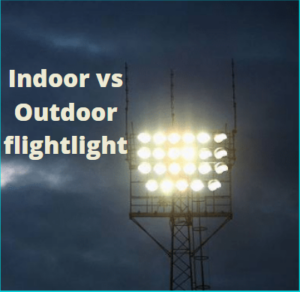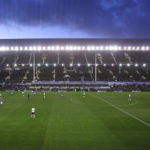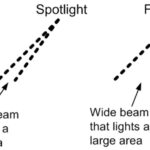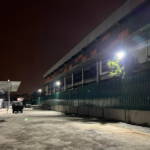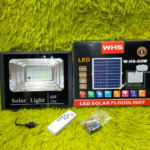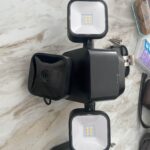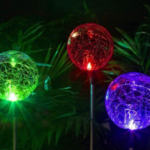
The manufacturers of floodlights make them for outdoors and indoors, respectively. When choosing floodlights whether indoor or outdoor, you need to know the basic differences between them. Unless you may end up choosing the wrong one.
The basic difference between indoor and outdoor floodlights is outdoor floodlights are more well built and well-sealed compared to indoor lighting to tolerate harsher weather conditions like; extreme temperatures, rain, and snow. On the other hand, indoor floodlights are designed for indoor uses as they are not as well sealed and well built to sustain in extreme weather. Also, indoor floodlights use low wattage bulbs as they don’t need to illuminate a very wide area but outdoor floodlights generally need high wattage bulbs for illuminating large outdoor areas.
This article will explain the differences between these two floodlights in detail.
Table of Contents
Differences between Indoor and Outdoor Floodlights
The differences between outdoors and indoor flood lights are reflected light, shading, lightweight, power, color temperature, and brightness.
But before we delve into their differences, let us answer the question;
What Are Indoor Floodlights Used For?
Indoor floodlights are used to brighten a specific location in the house with artificial instead of natural lighting. You can use indoor floodlights in areas like; garages and basements where there is little or no natural sunlight. So if you need much brighter lighting compared to the usual indoor bulb, you can use an indoor floodlight. Also, due to the advanced technology-led floodlight bulbs are more long-lasting and energy-efficient than ever. So using floodlight at home will cut down your coast as well.
Before choosing the bulb for your indoor floodlight, you need to decide whether you want a bright light or a warmer cozy light. If you are choosing the led bulb, you should look towards wattage or lumens. If you want softer bright white light, I recommend you choose less than 60 watts equivalent to a 750 lumens bulb. You if want warmer light, you can choose from 60 watts to 120 watts as your need.
However, indoor floodlights cannot withstand the harsher weather conditions outdoor. Therefore, their construction is moderate for moderate conditions without wetness.
What is an Outdoor Floodlight?
Outdoor floodlight is obviously a common form of floodlight to use in outdoor places like landscape, street, playground, stadium, neighborhood location, outdoor home, commercial places, etc. They are built more strongly to sustain in the extreme weather like rain, snow, hot summer, etc. They come at least ip65 rated so that they can sustain in dust, water, and snow. That means they are well sealed and well built to face tough conditions.
Typically, outdoor floods size measures up to 30/8″, which is around 3.75″ in diameter and 5 – 5.5″ in length.
Their Differences
It is best to differentiate them in terms of their location, shading, soft lightweight, color temperature, brightness, and power, respectively.
- Location
Indoor Floodlights
You can use indoor floodlights to illuminate damp locations which pass through moisture condensation. Indoor floodlights can be installed in places like indoor pools, bathrooms, porches, or exterior covered patios.
The rating of the bulbs should be at minimum IP44 meant for damp locations.
Outdoor
Wet locations are the specialty for outdoor floodlights. They are strong since they will be exposed to weather conditions like; snow and rainfall. The area where both the indoor and outdoor floodlights differ in terms of location is in their construction. The lights for the outdoors are sealed more tightly than the lights for indoor use.
At the same time, bulb ratings should be at IP65, IP66, or IP67 for exterior locations. The IP code rating of bulbs is according to the effectiveness of their sealing and their protection from dust, water, and other contaminations.
- Shading
Indoor Floodlights
Although it may be an unwelcome addition, shading the indoor floodlight shield is vital. That may be why restaurants use chandelier lampshades, which are a bit on the low side.
Lampshades produce little range of high-level illumination and warm-colored lighting source. That is why; they can generate maximum lighting and beautification for your food and desktop. In addition, the warm glare will never irritate your eyes.
Outdoors
On the other hand, outdoor floodlights do not need shading. Most especially, as they are artificial light fixtures consisting of broad beams and high-intensity. As a result, they can produce higher illumination than lamps.
You can use outdoor floodlights regularly to brighten your exterior playing fields or other sports events outdoors. Moreover, the most focused outdoor flood lights can be used to illuminate stage instruments for live performances like; plays and concerts.
- Brightness
Indoor Floodlights
Generally, indoor floodlights are ideal for home and office use with their natural brightness. Indoor floodlights production isn’t too dark or too bright. The bulb wattage for indoor floodlight is optional. Thus, you will have more chances to maneuver.
The brightness of this floodlight depends on its color temperature. Besides, if the color temperature is cool, the area it illuminates will be quite large. Also, the floodlight visual effect will be extremely clear.
Consequently, installing indoor LED floodlights with white color in conference rooms and public places is more recommendable. The reason is that the light helps people to remain awake. Whereas if the light is warm white, it is more suited to living rooms to make the entire space natural and cool.
Outdoor
Studies and research have shown that the brightness level for outdoor floodlights is ‘very’ bright. This artificial light with the beam spread around 45-degrees and 120-degrees. This type of floodlight is suitable for safety and visibility purposes.
They are normally used in playing fields, parking lots, and schoolyards. As for security lighting, the floodlights required should be much brighter. That is how it can prevent the chances of danger. Thus, there is the need to use around 700 to 1300 lumens for maximum brightness. On the other hand, floodlights with motion sensors need only to use around 300 to 700 lumens.
- Power Consumption
Indoor Floodlights
The indoor LED floodlight bulb wattage normally displays its power consumption in joules per second. Therefore, for higher wattage bulbs, its power consumption is also higher. But its level of brightness is not dependent on wattage.
LED indoor floodlight is highly powerful, and as a result, its bulbs provide brightness up to 10 watts. Moreover, due to the technological advancements of the present LED floodlights, it can generate higher illumination more than its contemporaries in wattage and energy saving.
Related Articles: Best battery-operated floodlight
Outdoors Floodlights
On the other hand, outdoor floodlights’ power consumption is around 0.12kW and operates 10 hours each day. As a result, it utilizes 1.2 kW energy consumption each day. Example; 0.12 kW for 10 hours or 36 kWh each month. Meaning; 1.2 kWh each day x 30 days.
The traditional halogen and incandescent floodlights are still used for landscape lighting. However, in comparison with other lighting, they are quite inefficient. Their power consumption per month is very high. For instance, a moderate outdoor halogen floodlight system can consume around $25 per month in electricity to function.
Can you Use Indoor Floodlights Outdoor?
Floodlights meant for the outdoors generally are built to withstand harsh weather conditions. If by chance, you make use of indoor floodlights for the outdoors, you will run a very high risk of rain seeping into the light. Thus; resulting in its circuit shutting off. Moreover, legally speaking, certain local authorities prohibit residents from using indoor floodlights outdoors.
Apart from the legal restrictions, there is a higher risk of an electrical fire outbreak. In addition, indoor floodlights are not constructed to tolerate outdoor weather conditions. That is the major reason why you shouldn’t.
The likelihood of moisture leaking into the lights is very high. And as a result, the moisture can cause a short circuit which will cause a fire. The only way to prevent such occurrence is to check the IP rating on the package of the light since there are various classes of floodlight’s IP ratings.
You dare not use any bulb whose IP rating is not up to IP65, IP66, or IP67. Most especially, exposing it directly to the weather.
However, if you must use the indoor floodlights outdoors, there are ways to make them less dangerous.
- Protect the bulb location. Don’t allow it to suffer direct exposure to snow or rain. For example, certain indoor flood light bulbs can withstand damp locations if placed on an enclosed balcony. But if you use them in open locations such as garden lamp posts, they are likely to fall apart.
- Check if the floodlight bulb is actually suitable for that outlet. The wattage shouldn’t be higher or lower. For example, putting a 100 watts bulb in an outlet for 70 watts will lead to overheating in the wires, thus destroying its insulation.
- Make use of non-conducting, weatherproof accessories to install your wiring. It is a common good practice, but it can also reduce the chances of electrical fires.
- Make sure that no flammable materials are found near the bulb. So that at any event of a fire, there will be no combustible material close by to aggravate it.
- Remember to connect the outdoors wiring to a GFCL, a prompt working circuit breaker. It can shut off the electric power at any on-ground event within 1/40 seconds.
Can you Put a Regular Bulb in a Floodlight?
Some of the available light sockets today still carry the Edison base. As a result, you can put a regular bulb in a floodlight socket if they have the same base. There shouldn’t be any resultant side effects.
Light sockets come with a maximum watts rating and are usually imprinted or branded on them. For plastic sockets, their maximum power is rated at 60 watts. But porcelain sockets are used for sockets with higher wattage. Initially, the important thing is the capacity for light bulbs to withstand the scorching heat produced during the time of its operation.
If you want to put a regular light bulb in a floodlight, there are certain things you need to consider. For instance, you need to consider
- the bulb
- ‘s fitting with the f
- loodlight socket.
- Check if the floodlight socket is meant to receive a particular bulb. You can only use the specific type of bulb it is built for in it.
Related Articles:
Floodlight vs spotlight. What are the differences?

